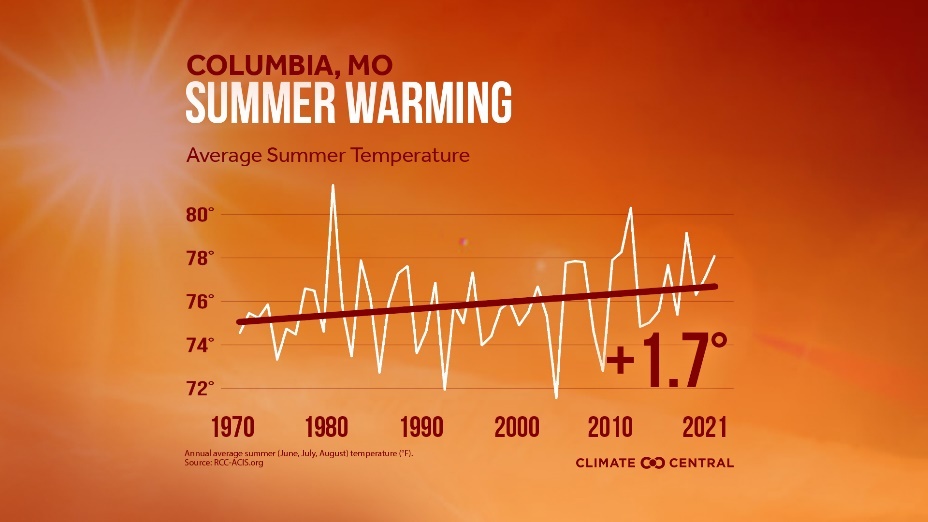Summer heat is no surprise to communities across Missouri – and it’s certainly something Columbia residents expect every year. However, the seasonal heat and humidity combined with rising temperatures due to climate change can make summers more than just uncomfortable. Soaring temperatures associated with the urban heat that we experience can have significant implications for our community’s public health and economy. That’s why Columbia is committed to understanding how urban heat impacts us and working with the community to develop solutions.
Columbia, like many other urban areas, experiences what is known as the Urban Heat Island (UHI) effect, which describes the phenomenon of in-city temperatures becoming consistently warmer than surrounding areas. This happens for a few reasons: because cities have fewer trees and more heat-absorbing surfaces (like roads and buildings), heat becomes trapped in place. When the sun sets, urban environments hold heat, making the area warmer even when the sun sets.
Consistently higher temperatures can translate to compromised public health. Heat-related illnesses like heat exhaustion and heatstroke become more prevalent, and poorer air quality resulting from heat and pollutants can create or exacerbate respiratory illnesses. In fact, heat causes more deaths in the United States per year than all other weather phenomena – even tornadoes and flooding.
Climate change increases the UHI effect by increasing temperatures on a larger scale as greenhouse gas emissions keep heat trapped in our atmosphere. In Columbia, we’ve seen our average summer temperature increase by 1.7°F since the 1970s: a trend that will continue without action for sustainability.
Graphic from Climate Central
Rising temperatures increase the adverse impacts of urban heat – especially on certain communities that are especially vulnerable to urban heat’s effects. Factors like race, income, health status, career type, housing quality/accessibility, and more all contribute to a person’s vulnerability to extreme heat.
In order to combat the impacts of urban heat, we first needed to identify where urban heat islands exist in Columbia. To do that, we hosted a Heat Watch community science project called “Show Me the Heat.” Volunteers attached heat sensors to their vehicles and drove routes through the city throughout the day on one of the hottest days of the year. The data was used to create models showing which areas of the city get and stay the hottest, as well as which areas cool most quickly. You can explore the interactive maps from SMTH and see how hot your neighborhood is.
Average heat map and overnight cooling map for the city.
Now that we know where the hottest neighborhoods in Columbia are at, we’re beginning to meet with people who are most impacted by urban heat and the community-based groups that work with them. Our new Community Resilience Organizer, Corrina McClee, will be spending the summer hosting neighborhood resilience meetings in the hottest places around Columbia listening to people about their experiences with urban heat including: how it effects their health, actions to stay cool, places to cool off, programs and services used to offset the burden of summer heat.
The best way to avoid extreme heat in the future is to lower the amount of greenhouse gas (GHG) emissions we release into our atmosphere that cause a rise in average temperatures. Columbia’s Climate Action and Adaptation Plan lays out a vision and strategy to address climate change and draw down greenhouse gas emissions, and individual actions are key to the Plan’s success.
The energy sector is the largest contributor to our community greenhouse gas emissions – and residential energy creates 35% of our community’s energy emissions. In the summer months, you may notice your power bill increasing due to increased energy used to cool our homes, but there are a few steps you can take to save energy (and money) even when the weather gets warm:
- Utilize ventilation: During cooler evenings or early mornings, try opening windows on opposite sides of your home to create a cooling breeze without the use of air conditioning. You can also use ceiling or floor fans in your home to circulate fresh air.
- Harness the power of shade: Keep your curtains, blinds, or shades closed during the day to keep the sun from heating up your home.
- Optimize your thermostat: If your cooling system has the option, try to keep your home at a higher temperature when you’re away from home. When you are home, aim for a comfortable but energy-efficient temperature to keep your air conditioning from using unnecessary energy.
- Find energy-efficient options: Replacing your old cooling system can help increase energy efficiency and save you money on your utility bills. Columbia provides rebates on air conditioners and heat pumps (which also can work as coolers!). Utilizing solar power rebates can also limit our climate impact by decreasing the use of fossil fuels in our homes’ energy systems
Previous Post
Sustainable Transportation in CoMo
Next Post
Fall In LOVE with These 4 City Sustainability Programs








